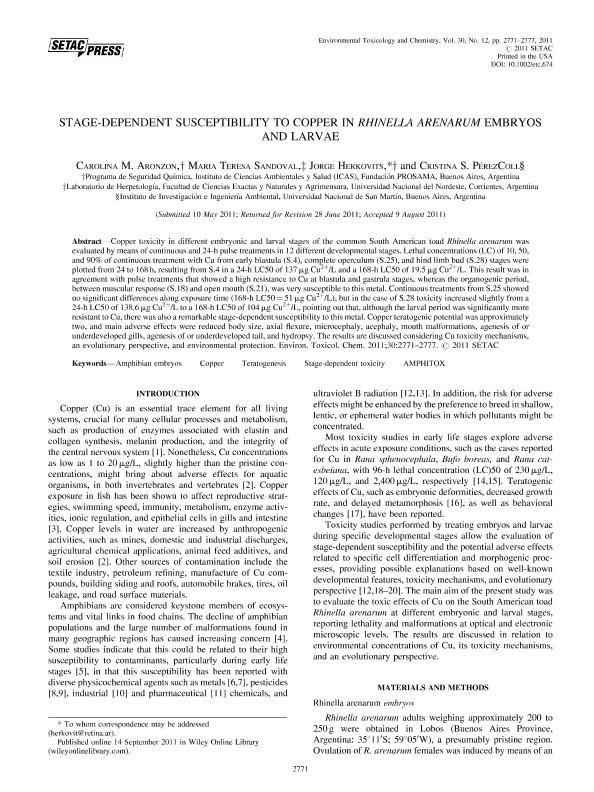Artículo
Stage dependent susceptibility to Copper in Rhinella arenarum embryos and larvae
Fecha de publicación:
12/2011
Editorial:
Society of Environmental Toxicology and Chemistry
Revista:
Environmental Toxicology and Chemistry
ISSN:
0730-7268
Idioma:
Inglés
Tipo de recurso:
Artículo publicado
Clasificación temática:
Resumen
Copper toxicity in different embryonic and larval stages of the common South American toad Rhinella arenarum was evaluated by means of continuous and 24-h pulse treatments in 12 different developmental stages. Lethal concentrations (LC) of 10, 50, and 90% of continuous treatment with Cu from early blastula (S.4), complete operculum (S.25), and hind limb bud (S.28) stages were plotted from 24 to 168 h, resulting from S.4 in a 24-h LC50 of 137 mg Cu2þ/L and a 168-h LC50 of 19.5mg Cu2þ/L. This result was in agreement with pulse treatments that showed a high resistance to Cu at blastula and gastrula stages, whereas the organogenic period, between muscular response (S.18) and open mouth (S.21), was very susceptible to this metal. Continuous treatments from S.25 showed no significant differences along exposure time (168-h LC50¼51mg Cu2þ/L), but in the case of S.28 toxicity increased slightly from a 24-h LC50 of 138.6 mg Cu2þ/L to a 168-h LC50 of 104 mg Cu2þ/L, pointing out that, although the larval period was significantly more resistant to Cu, there was also a remarkable stage-dependent susceptibility to this metal. Copper teratogenic potential was approximately two, and main adverse effects were reduced body size, axial flexure, microcephaly, acephaly, mouth malformations, agenesis of or underdeveloped gills, agenesis of or underdeveloped tail, and hydropsy. The results are discussed considering Cu toxicity mechanisms, an evolutionary perspective, and environmental protection.
Palabras clave:
COPPER
,
AMPHIBIAN DEVELOPMENT
,
STAGE DEPENDENT SUSCEPTIBILITY
Archivos asociados
Licencia
Identificadores
Colecciones
Articulos(SEDE CENTRAL)
Articulos de SEDE CENTRAL
Articulos de SEDE CENTRAL
Citación
Aronzon, Carolina Mariel; Sandoval, María Teresa; Herkovits, Jorge; Perez Coll, Cristina Silvia; Stage dependent susceptibility to Copper in Rhinella arenarum embryos and larvae; Society of Environmental Toxicology and Chemistry; Environmental Toxicology and Chemistry; 30; 12-2011; 2771-2777
Compartir
Altmétricas




